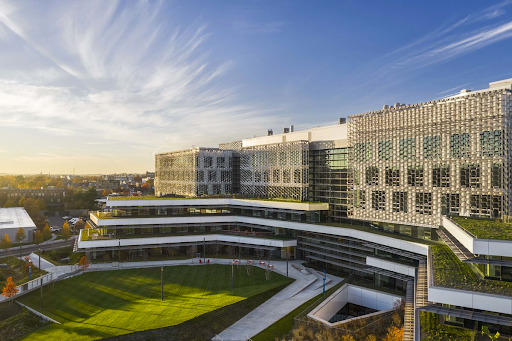As the world battles climate change and global warming, sustainability has become a crucial aspect of building design in the past decade. From the materials used in construction to the energy consumption of buildings, sustainability has become a key factor in determining the long-term viability of a project.
As we progress, a more holistic and well-rounded approach to sustainability seems to be taking shape. Nowadays, architects are not only considering the environmental impact of construction and operation, but also the economic, social, and cultural implications of the built environment. With this ideology, the concept of “net-zero buildings” has emerged as the next big thing in building design.
What is a Zero Energy Building?

Net-zero buildings are structures that produce as much energy as they consume, effectively creating a self-sustaining energy system. They are designed to be energy-efficient, using high-efficiency appliances, lighting, HVAC systems, and insulation, and to generate renewable energy through the use of solar panels, wind turbines, and geothermal systems.
Net-zero buildings aim to reduce their carbon footprint and minimize their impact on the environment. They often incorporate energy management systems to monitor and control energy usage, as well as sustainable materials and passive design strategies to reduce energy demand and improve indoor environmental quality.
The Need for Net-Zero Buildings

The need for net-zero buildings is growing as the world faces the pressing challenge of the climate crisis. With global temperatures rising and extreme weather events becoming more frequent, it is clear that action must be taken to reduce our carbon footprint and mitigate the impacts of climate change. One way to do this is through the creation of net-zero buildings, which can play a critical role in reducing our overall energy consumption and dependence on fossil fuels.
Net-zero buildings are a carbon conscious response to the growing need for sustainability in the built environment. With the construction industry responsible for a significant amount of the world’s greenhouse gas emissions, it is essential that we look for ways to create buildings that are energy-efficient, environmentally responsible, and sustainable. By incorporating renewable energy systems, energy-efficient design, and sustainable materials, net-zero buildings offer a solution to the problem of unsustainable building practices and help to reduce the impact of the built environment on its unbuilt counterpart.
Top 6 Criteria to Design Net Zero Building

The demand for net-zero buildings is speedily increasing across the globe. Architects and urban designers are making a conscious effort to innovate designs for creating a sustainable future. Below are the 6 key factors that need to be considered while designing a net-zero building.
1. Energy Efficiency
To design a net-zero building, it’s essential to have a comprehensive understanding of energy efficiency and renewable energy generation. This includes the latest technologies, techniques, and best practices for reducing energy consumption and maximizing the use of renewable energy sources. Energy efficiency can be achieved through a variety of means, including high-efficiency appliances, lighting, HVAC systems, design strategies, and insulation. These features help to reduce the amount of energy required to run the building, which in turn reduces its overall carbon footprint.
2. Passive Design Strategies
An essential element of net-zero buildings is the incorporation of passive design strategies that reduce energy demand and improve indoor environmental quality. These strategies include the use of natural light, ventilation, and shading to control temperature and improve air quality. They also often feature green spaces, such as rooftop gardens, which can improve air quality, reduce urban heat islands, and provide additional energy benefits through the use of shading and insulation.
3. Renewable Energy Generation
A building must produce as much energy as it consumes for achieving net zero energy. This is typically achieved through the use of renewable energy sources, such as solar panels, wind turbines, and geothermal systems. These systems generate clean, renewable energy that can be used to power the building and reduce its dependence on the grid and fossil fuels. The use of multiple renewable energy sources can also provide a more resilient and stable energy supply, ensuring that the building remains net-zero even in the face of changing weather conditions.
4. Smart Energy Management Systems
Net-zero buildings also often incorporate energy management systems, which allow the building’s energy usage to be monitored and controlled. These systems can be used to track energy consumption and production, optimize energy usage, and ensure that the building remains in balance. By using data from these systems, building owners and managers can make informed decisions about energy usage and make changes to improve efficiency and reduce costs.
5. Sustainable Materials
Sustainable materials are naturally available in the environment or are made from recycled resources. They typically have a lower carbon footprint throughout their lifecycle in comparison to conventionally-used materials. This includes materials used for construction, as well as products used within the building, such as furniture, flooring, and paint. The use of sustainable materials can also improve indoor air quality, enhance durability and longevity, and increase occupant comfort. For example, using low-emitting materials such as low-VOC (volatile organic compounds) paint and adhesives can help to reduce indoor air pollution.
6. Adaptive Reuse
Adaptive reuse involves retrofitting existing structures to create net-zero buildings. This approach involves improving the building envelope, upgrading HVAC and lighting systems, installing renewable energy systems, and improving water efficiency through plumbing upgrades and low-flow fixtures. These upgrades can lead to reduced energy consumption, improved heating and cooling efficiency, clean energy generation, and improved water efficiency. The result is a net-zero building that is energy-efficient and environmentally friendly.
